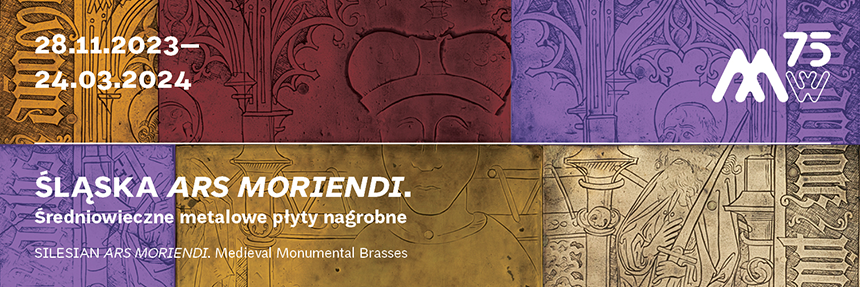The Lubiąż Necropolis
The necropolis of the Silesian branch of the Piast dynasty in the monastic Church of the Assumption of the Blessed Virgin Mary in Lubiąż was founded in the early fourteenth century. Although at least nineteen dynasts were buried there, only three monumental brasses (stone stab tombs decorated with metal appliques), located in the church’s presbytery, have been preserved. They are thought to be works by local masters and display the Flemish influence.
The earliest of the three – and at the same time the earliest monumental brass preserved in the whole of historical Silesia – is the monument of Duke Boleslaus I the Tall. Select appliques from the two remaining monuments, commemorating the burial places of Dukes Konrad of Żagań and Przemko of Głogów, are featured at the exhibition.
The monumental brasses depict the dukes as living, their standing figures framed by ornate architectural arcades symbolizing their hope of entering the Heavenly Jerusalem. The monument’s composition is inspired by the iconography of ducal seals. Boleslaus I the Tall and Przemko of Głogów are depicted wearing armour and presenting their weapons to emphasize their temporal power and military prowess. The mitras on their heads and the Silesian eagle on their shields are symbols of their princely status. Representing the deceased as princes and brave knights may have been inspired by the figure of Henry IV the Righteous from his splendid tomb.
Duke Konrad of Żagań, provost of Wrocław Cathedral, is depicted in a different manner. Although he also wears his ducal mitra, there is no armour, just a Modest tunic. His hands – raised, open, with the inside turned towards the viewer – likewise emphasize his modesty, humility, purity and noble intentions, the qualities befitting a clergyman.
The last monumental brass from Lubiąż comes from the same Church of the Assumption of the Blessed Virgin Mary but was never part of the Piast necropolis. It commemorates knight Martin Buzwoy, a vassal of Duke Boleslaus III of Legnica and Brzeg, whose burial place was likely by the entrance to the Ducal Chapel. Although only seven brass appliques are all what has survived of his monument, its archival photographs show that in terms of form and composition it was similar to the ducal monuments in the church’s presbytery.
Il. 1: Drawing showing the reconstruction of the engraved decoration of the first monumental brass of Duke Boleslaus I the Tall, reproduced after: J. Kębłowski, Pomniki Piastów Śląskich w dobie średniowiecza, Wrocław 1971, fig. 1, as modified by Romuald Kaczmarek.
Il. 2: Archival photograph of the monumental brass of Duke Boleslaus I the Tall in the monastic Church of the Assumption of the Blessed Virgin Mary, Lubiąż Abbey, reproduced after: H. Lutsch, Bilderwerk schlesischer Kunstdenkmäler, Mappe III: Fortsetzung des Barockstils, Breslau 1903, Tfl. 221, Abb. 4.
